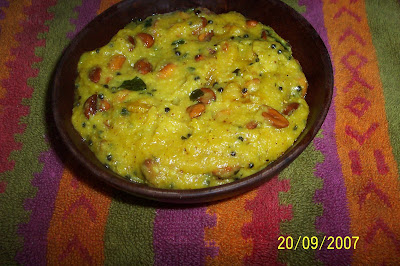
 I don't know why - perhaps it is to do with our tribal origins - human beings have an inherent need to form groups or cliques, each of which firmly believes in its own superiority over the others. You can see this behaviour in children as young as three on a playground, and of course, as adults, the belongingness and superiority need seems to get reinforced. Naturally, then, as a Kannadiga, though born and brought up in Delhi, I firmly believe in the superiority of South Indian food, in particular Karnataka food, over anything else the world has to offer, in terms of taste, nourishment and satisfaction. I was thrilled to find a food blog event on Karnataka recipes for this month. I debated whether to plunge into BBH - Bisi bele bhaath - a signature dish for both Karnataka and myself - one which my friends repeatedly request when they come over. But in 37 degree heat, BBH ( or RC - reinforced concrete as we fondly call it in the family) is too heavy and spicy, so I decided to save that and make one of my summer favourites.
I don't know why - perhaps it is to do with our tribal origins - human beings have an inherent need to form groups or cliques, each of which firmly believes in its own superiority over the others. You can see this behaviour in children as young as three on a playground, and of course, as adults, the belongingness and superiority need seems to get reinforced. Naturally, then, as a Kannadiga, though born and brought up in Delhi, I firmly believe in the superiority of South Indian food, in particular Karnataka food, over anything else the world has to offer, in terms of taste, nourishment and satisfaction. I was thrilled to find a food blog event on Karnataka recipes for this month. I debated whether to plunge into BBH - Bisi bele bhaath - a signature dish for both Karnataka and myself - one which my friends repeatedly request when they come over. But in 37 degree heat, BBH ( or RC - reinforced concrete as we fondly call it in the family) is too heavy and spicy, so I decided to save that and make one of my summer favourites.Mangoes are called the king of fruit and for most Indians they truly are, with their intensely fragrant aroma and succulent golden honey flesh. The number of things the mango lends itself to is also amazing, from Thai salad ( use the semi-ripe mango as an alternate to raw papaya in Som Tham ) to shrikhand, lassi, pickles, ice creams, shakes to being eaten as they are, the juice dripping from one's chin, salted and chillied for the Thothapuri variety or without accompaniment for the badami, Malgoa, Hapoos or the Chausa. One mango dish I look forward to at each Kannadiga wedding down south is fresh mangi pickle - made and consumed within a few hours.
A Karnataka mango dish that appears regularly at our table in the summer is mango rice- maavinakaayi chitra anna - tart, spicy and tongue-ticklingly chatpata, its texture a melange of soft rice and crunchy peanuts. A perfect summer dinner involves mango rice, accompanied by cold curds, straight from the fridge, and a crisp cucumber salad, followed by sweet, sweet mangoes eaten the desi way - skin ripped off using one's teeth, and the flesh bitten into chunks, followed by the ritual suckling and slurping of the gotta - the seed - until it becomes bleached white.
Maavinakayi Chitra Anna

Ingredients:
2-3 green, raw mangoes, grated
1 handful grated fresh coconut, or desssicated coconut
2-3 green chillies
1 dried red chilli
2 tsp mustard seeds
1 sprig curry leaves
1 tsp heeng ( asafoetida)
Pinch turmeric
1/2 cup raw peanuts in their skins
3 tbsp oil
Salt to taste
1 cup long grained basmati rice, cooked and spread out on a platter
Handful coriander leaves, chopped fine and half cup fresh coconut for garnish
Put the grated mango, coconut, green chillies, red chillies and 1 tsp mustard seeds into the blender and blend until it becomes a smooth mass.
Heat 1/2 the oil in a bandley ( wok).
Add 1 tsp of the mustard seeds and wait for them to pop.
When they pop, add the turmeric, then curry leaves, then heeng.
Add the mango-coconut paste and stir, cooking on a medium flame for 2-3 minutes until the mango is cooked but not overcooked. Set aside.
Heat the rest of the oil and put in the peanuts. Fry them on a medium flame, stirring occasionally until they turn crisp and brown. Remove from heat.
Add the mango paste and the peanuts to the rice, as well as salt, and mix well, checking to see if the flavour is uniformly mixed. It should taste sharply sour, salty and spicy. In case the mango is not sour enough, you can add a bit of lemon juice to the rice.
Let the rice stand for 2-3 hours, so the flavours are fully absorbed and mature.
Garnish with coriander and coconut before serving.
This dish is served cold, so it can be made well ahead of time if you are entertaining guests.
1 comment:
Beautiful looking Chitrann with Maavinkai, thank you for sending!:)
Make sure to check the round up and leave a comment!:))
Post a Comment